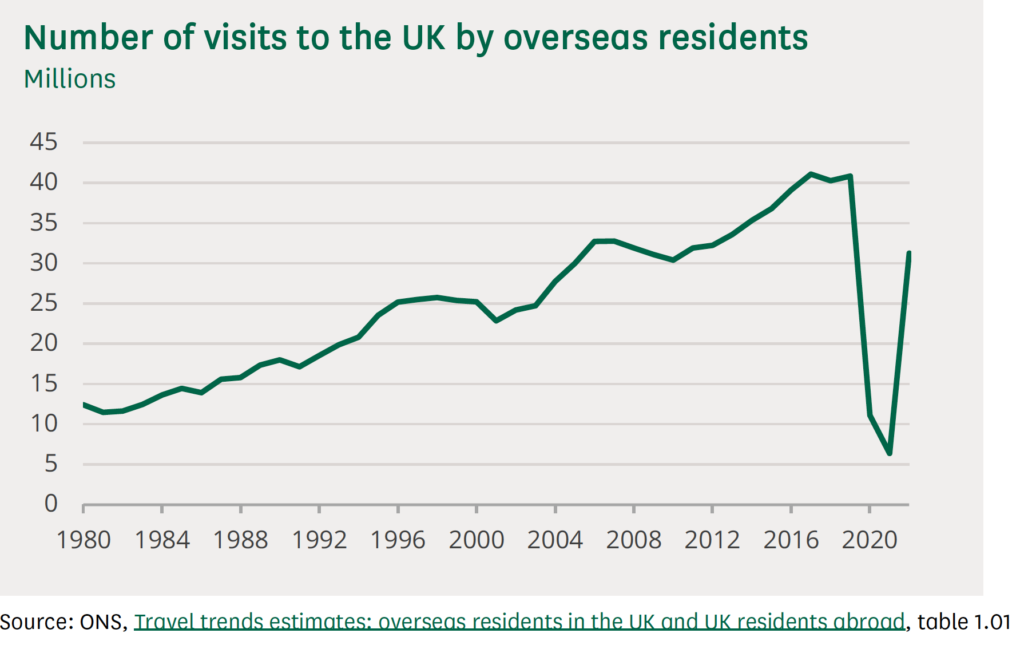The landscape of tourism in the UK, characterized by its rich historical tapestry and vibrant cultural scene, has experienced significant transformations over recent years.
The sector, vital for the economy, encountered unprecedented challenges, notably the COVID-19 pandemic, Brexit-related adjustments, and the evolving global economic conditions.

This article delves into the current state of tourism in the UK, exploring inbound, outbound, and domestic tourism trends, the economic impact of the industry, recent challenges it faces, government policy responses, and the structural framework guiding tourism development.
Inbound Tourism: A Slow Recovery
Inbound tourism to the UK saw a stark decline due to the pandemic, with overseas residents making 31.2 million visits in 2022, down from 40.9 million in 2019.
The spending also saw a downturn, with tourists spending £26.5 billion in 2022 compared to £28.5 billion in 2019.
While there is optimism with VisitBritain expecting a full recovery by the end of 2024, the sector remains under pressure from Brexit aftermaths and changes in international travel behaviours.
The average length of stay has increased, indicating a shift towards longer visits, primarily for visiting family and friends.
Outbound Tourism: Changing Preferences
The number of trips taken by UK residents abroad decreased to 71.0 million in 2022 from 93.2 million in 2019, with spending also seeing a decline.
This shift reflects a changing landscape of travel preferences among UK residents, potentially influenced by increased awareness of sustainable travel and the economic pressures of the cost of living crisis.
Domestic Tourism: A Beacon of Hope
Interestingly, domestic tourism has shown resilience, with British residents making 126 million overnight visits within Great Britain, spending £32.9 billion in 2022.
The spread of domestic tourism across the UK demonstrates a more diversified approach to exploring the nation, less concentrated on London and more on regional destinations.
Economic Impact and Employment
Tourism’s contribution to the UK economy was significant, with a £74 billion economic output in 2019. The sector directly accounted for the employment of 1.7 million UK workers, emphasizing its importance to the national economy. However, the industry faces ongoing challenges from inflation, staff shortages, and the cost of living crisis.
Recent Challenges and Government Response
The sector’s recent hurdles include the impact of COVID-19, adjustments post-Brexit, staff shortages, and changes in international travel regulations. The government’s response, through the Tourism Recovery Plan and the review of Destination Management Organisations (DMOs), aims to support the sector’s recovery and long-term sustainability.
Policies focusing on promoting domestic and inbound tourism, addressing staffing issues, and enhancing the UK’s attractiveness as a tourist destination form the crux of these efforts.
Looking Ahead: A Sustainable and Inclusive Future
As the UK tourism sector navigates these challenges, the focus shifts towards sustainable growth, inclusivity, and enhancing visitor experiences through digital innovation and improved infrastructure.
The establishment of Local Visitor Economy Partnerships (LVEPs) and targeted government initiatives aim to bolster the sector, ensuring its contribution to the economy and employment continues to grow.
In conclusion, while the UK tourism sector has faced unprecedented challenges, the resilience shown by domestic tourism, strategic government policies, and a focus on sustainable development indicates a positive trajectory. The sector’s ability to adapt, innovate, and prioritize inclusivity and sustainability will be key to its recovery and future prosperity, contributing significantly to the UK’s cultural and economic landscape.


